Guadalcanal campaign
Battle of Guadalcanal
Part of: World War II, Pacific War
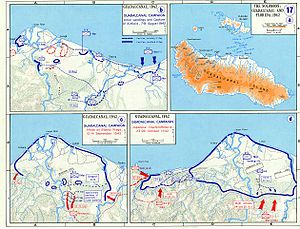
Fighting on Guadalcanal, 1942
Overview - Pacific War
Battle of Guadalcanal (1942-1943)
Tulagi and Gavutu-Tanambogo - Savo Island - Tenaru - Eastern Solomon Islands - Bloody Ridge - 1st Matanikau River - Cape Esperance - Henderson Field - Santa Cruz Islands - 2nd Matanikau River - Koli Point - Carlsons Patrol - Guadalcanal - Tassafaronga - Mount Austen - Rennell Island - Operation Ke - Operation Cleanslate
Campaign for the Solomon Islands (1942-1945)
Southern Solomon Islands
1942Tulagi - Guadalcanal
1943Operation
I - Operation Vengeance - SO
Central Solomon Islands
1943New
Georgia - Kula Gulf - Kolombangara - Vella Gulf - Vella Lavella
Northern Solomon Islands
1943-1945Treasury Islands
- Choiseul - Empress Augusta Bay - Bougainville - Green Islands
The Battle of Guadalcanal was one of the turning points of World War II in the Pacific theater of war. The US code name was Operation Watchtower. For the first time, U.S. forces went on the offensive against Japan, which had occupied much of the western Pacific since December 1941. From August 1942 into February 1943, the island of Guadalcanal was the focus of very heavy fighting on land, sea, and air. Even the supply routes to Guadalcanal were fiercely contested. Both sides lost aircraft carriers, several cruisers, and numerous smaller ships. In the course of the conflict over Guadalcanal, about 50 ships from both sides were sunk by air attacks and in naval battles, so that the waters around Lunga were given the name Ironbottom Sound. On the American side, by the end of the fighting, the number of sailors killed at sea exceeded the number of soldiers killed in months of tough jungle fighting.
In the numerous air battles, however, Japan also lost most of its remaining pilots trained before the war. Their replacements, taken from the schools prematurely, dropped out faster and had to be replaced in turn. The flying level of the Japanese pilots sank steadily since then and finally led to kamikaze, the only remaining means of resistance.
Previous story
As early as the beginning of May 1942, the Japanese forces succeeded in establishing a base on Tulagi Island, north of Guadalcanal, as part of Operation MO. In early summer, the Japanese then expanded their territory to Guadalcanal itself and began to establish a small air base near Honiara, called Lunga Point, after the river delta of the same name in the vicinity. This airfield would have given the Japanese control of the Southern Solomons. The Australian supply routes and also New Guinea were accessible from here.
When the US Joint Chiefs of Staff (JCS) became aware in the early summer of 1942 that the Japanese were building an airfield on Guadalcanal, it decided, at the instigation of Admiral Ernest King, Commander in Chief of the US Navy, that the Allied counteroffensive should begin in Guadalcanal. The island gained strategic importance with the establishment of an airfield, as Japanese long-range Mitsubishi G4M bombers would have been able to attack the sea route between the US and Australia.
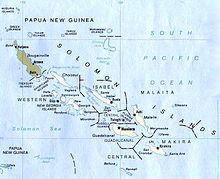
The Solomon Islands
Landing
Guadalcanal
The American Landing
On the night of August 7, 1942, Task Force 61 under Vice Admiral Frank Jack Fletcher moved some 19,000 American Marines into position to attack and occupy Guadalcanal Island and the smaller Tulagi, slightly to the north.
The landing fleet, Task Group 61.2, consisting of 13 large troop carriers, six large supply units, and four smaller transport destroyers, was accompanied by eight cruisers, including three Australian, 15 destroyers, and five fast minesweepers. This force was led by Rear Admiral Richmond Kelly Turner.
Further out to sea was Task Group 61.1, which included three aircraft carriers USS Saratoga, USS Enterprise, and USS Wasp, with a total of about 250 aircraft, as well as the battleship USS North Carolina, six cruisers, 16 destroyers, and five supply tankers. They were all under the command of Rear Admiral Leigh Noyes.
The long battle for Guadalcanal began shortly after 6 a.m. with the shelling of Japanese positions near Lunga Point by the heavy cruiser Quincy.
The 1st Marine Division of the U.S. Marines under Major General Alexander A. Vandegrift landed around 9 a.m. at Red Beach, a small, gray-sand beach near the Tenaru River. Because of their numerical superiority, the Marines met little resistance here. The Japanese defenders suffered heavy casualties and had no significant successes. By 9 August, most of the 19,000 Marines had been brought ashore.
In the afternoon of the following day the Americans were in possession of the almost completed airfield. The surviving Japanese units had retreated far into the interior of the island and left a lot of valuable equipment to the conquerors, which was to prove very useful for the new owners in the following time.
A typical procedure for landing operations at that time was the haphazard bringing in of supplies. The unloading of the ships was so fast that after a relatively short time the beaches around Lunga Point were filled with material that could not be brought inland fast enough. Japanese air raids hardly interfered with this endeavor. But when the transport ships were withdrawn on 9 August, not one of them had been fully unloaded. As a result, supply shortages occurred over the next several weeks as the Japanese attempted to retake the strategically important airfield with air and sea attacks.
Likewise, not all supplies and soldiers could be brought ashore, as Admiral Fletcher did not want to fight a naval battle with outnumbered forces and therefore left his fleet near the landing zone for only two days. Vandergrift had the transport fleet retreat a day later.
Japanese counterattacks
The Japanese response to the landing was swift but unsuccessful. At Rabaul, the nearest Japanese base, Vice Admiral Mikawa Gun'ichi assembled a small relief force and embarked them for Guadalcanal. One of the transports was sunk during the night by the American submarine S-38. 300 men died and the troop transport turned back.
Meanwhile, Japanese planes took off from Rabaul to search for the American carriers. Failing to find them, they appeared over the invasion fleet in the early afternoon of 7 August. 27 bombers and some Zero fighters bombed the landing forces and ships from high altitude. All the planes were lost to American fighters launched from the carriers or ditched on their way back. They had done almost no damage.
Also the next day the Japanese airplane attacks continued. The Japanese again attacked the landing fleet with torpedoes. The ships were by now relatively well protected in a sound. A torpedo hit a destroyer in the bow and a crashing bomber hit a transport ship, which subsequently sank. Flak from the ships caused the Japanese air force to lose half of the aircraft it had deployed.
Tulagi, Gavutu and Tanambogo
See also: Battles around Tulagi and Gavutu-Tanambogo
At about 8 a.m., Allied Marines landed to the southwest of the small island of Tulagi, north of Guadalcanal. They formed a front line across the small island and attempted to push the Japanese eastward. A light cruiser and two destroyers pounded the Japanese with their artillery. The 500 Japanese stationed on the island were also part of a Marine unit. By the evening of August 7, the Americans had pushed the severely depleted Japanese back to the southeast of the island. During the night the Japanese made a few attempts to break out, but when American reinforcements crossed from Guadalcanal, the island was quickly taken. It took several more days to overcome the last of the Japanese defenders. The fighting cost the lives of 45 American Marines and nearly all of the Japanese.
Tulagi was established to support the fighting on Guadalcanal as an emergency port for damaged ships and a base for seaplanes and torpedo boats.
The two islands of Gavutu and Tanambogo a few miles to the east were as hard-fought as Tulagi. There the Japanese maintained a seaplane station captured by the Australians in May. After all the planes had been destroyed by American carrier planes, the pilots, ground crew, and some marines were left with only the option of continuing to fight as infantrymen.
Both islands were bombed before landing, but the Japanese were still able to offer considerable resistance, especially on Gavutu. The fighting continued throughout the day and the following night. Only after reinforcements arrived for the Americans on the morning of August 8, the island could be taken.
The attack on Tanambogo on the afternoon of August 7 was a failure, so that the island was still in Japanese hands the next day. Heavy bombardment from Navy ships then enabled the Americans to take the island. But just as on Tulagi, it took days to break the fighting spirit of a few Japanese. Seventy Marines lost their lives and only a few Japanese were captured.
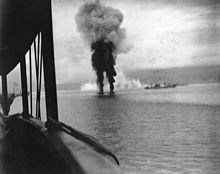
Rising smoke from two downed Japanese planes
.jpg)
Japanese bomber of the type Mitsubishi G4M (code name: Betty) in the sea
.jpg)
Japanese torpedo planes in defensive fire
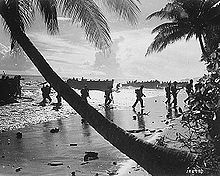
Landing of American troops of the 160th Infantry Regiment on Guadalcanal Beach
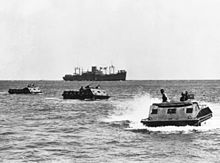
Amphibious landing units on their way to Guadalcanal beach. The ship in the background is the President Hayes.
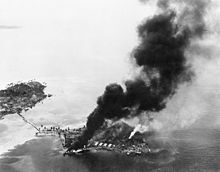
Gavutu and Tanambogo on attack day
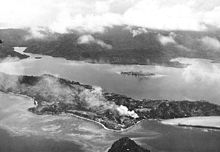
Fire on Tulagi

Landings on Tulagi and Gavutu
Questions and Answers
Q: When did the Guadalcanal Campaign take place?
A: The Guadalcanal Campaign took place between August 7, 1942 and February 9, 1943 in the Pacific theatre of World War II.
Q: What was the aim of Allied forces during this campaign?
A: The aim of Allied forces during this campaign was to make supply routes between the U.S., Australia, and New Zealand safer by landing on the islands of Guadalcanal, Tulagi, and Florida in the southern Solomons.
Q: Who fought against each other during this campaign?
A: During this campaign, Allied forces fought against Imperial Japanese forces.
Q: Where did the fighting take place?
A: The fighting took place on and around the island of Guadalcanal in the southern Solomon Islands.
Q: Was it one of the first long campaigns in the Pacific?
A: Yes, it was one of the first long campaigns in the Pacific.
Q: Was it a decisive and strategically important campaign for World War II?
A: Yes, it was a decisive and strategically important campaign for World War II.
Q: When did Allied forces start landings on these islands?
A: Allied forces started landings on these islands on August 7th 1942.
Search within the encyclopedia